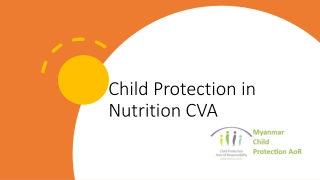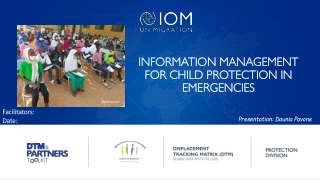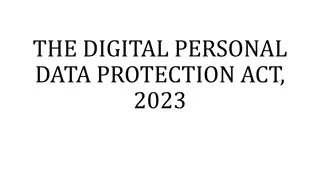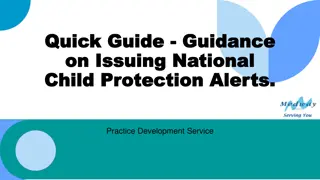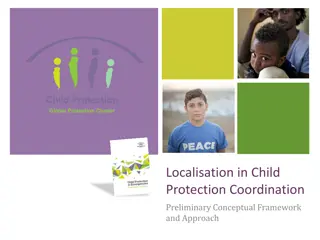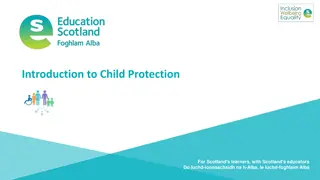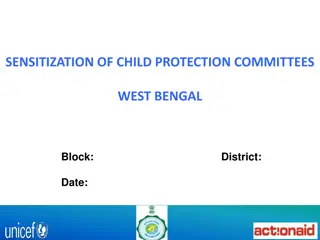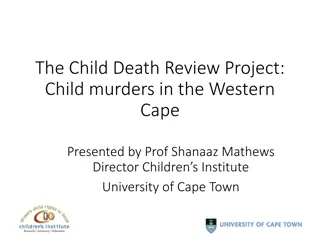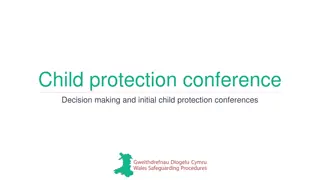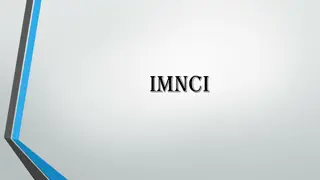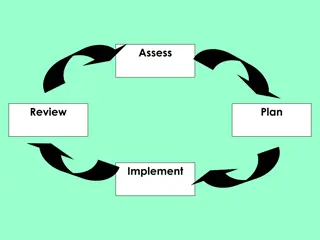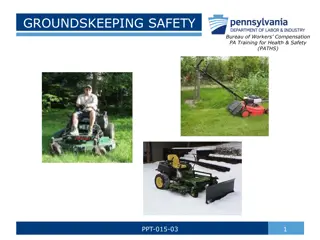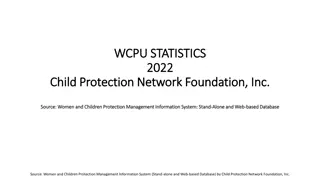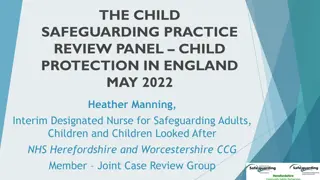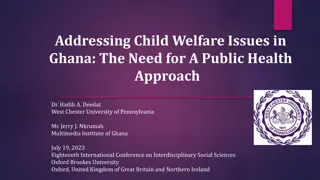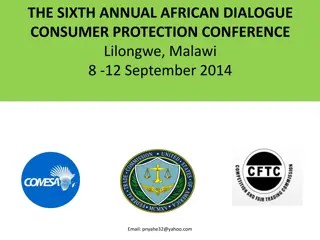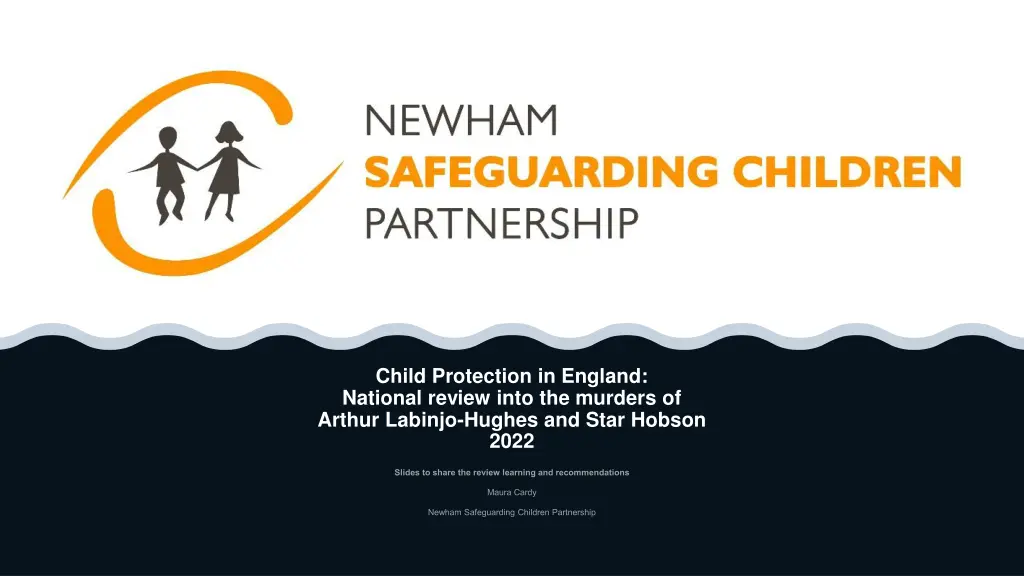
National Review into Child Protection Failures: Arthur Labinjo-Hughes and Star Hobson Murders 2022
Explore the national review into the tragic murders of Arthur Labinjo-Hughes and Star Hobson in England. This review delves into the shortcomings in child protection, highlighting weaknesses in information sharing, critical thinking, and leadership within and between agencies. Discover why these issues persist and how agencies can improve to prevent similar tragedies in the future.
Download Presentation

Please find below an Image/Link to download the presentation.
The content on the website is provided AS IS for your information and personal use only. It may not be sold, licensed, or shared on other websites without obtaining consent from the author. If you encounter any issues during the download, it is possible that the publisher has removed the file from their server.
You are allowed to download the files provided on this website for personal or commercial use, subject to the condition that they are used lawfully. All files are the property of their respective owners.
The content on the website is provided AS IS for your information and personal use only. It may not be sold, licensed, or shared on other websites without obtaining consent from the author.
E N D
Presentation Transcript
Child Protection in England: National review into the murders of Arthur Labinjo-Hughes and Star Hobson 2022
Those using the slide pack can tailor the points in the discussion slides to their own audience Black slides for all audiences. Purple slides additional for a more specialist or strategic audience. Slides 2-9 Review introduction and overview Slides 10 -15 Analysing the findings: Practice and Practice Knowledge Slide 16 Questions on Practice and Practice Knowledge Guide to using this slide pack Slides 17-20 Analysing the findings: Systems and Processes Slide 21: Questions on Info-sharing; Behavioural Bias; Critical Thinking Slides 22-23 Analysing the findings: Leadership and Culture, Wider Service context Slide 24: Questions on Leadership & Culture and Wider Service context Slides 25-27 Review recommendations Slide 28 Key messages for all Safeguarding Partners Slide 29 Feedback on the presentation Slide 30-32 Recommendation for multi-agency child protection units Slide 33-34 Specialist skills Slide 35 Questions for discussion Slide 36 Recommendation re domestic abuse Please provide feedback on the points for discussion to the LSCB.Administrator@newham.gov.uk
Review overview Arthur died June 2020, aged 6 years. Father s female partner convicted of his murder and father of his manslaughter. Arthur lived in Solihull. Star died September 2020, aged 16 months old. Mother s female partner convicted of her murder and mother of causing or allowing her death. Star lived in Bradford. Widespread public distress about the circumstances of their deaths. Questions why children had experienced such gross abuse and suffering when seemingly in plain sight of public agencies. Adults who should have been caring for Arthur and Star are responsible for their deaths. This review is to evaluate the role of agencies. How agencies acted to protect Star and Arthur, and what factors enabled or limited their ability to do so, so we can identify improvements for the future. Both children died during the Covid-19 pandemic
What went wrong? Weaknesses in info-sharing and info-seeking within & between agencies Lack of robust critical thinking and challenge within & between agencies Failure to trigger multi-agency CP processes at a number of key moments Skills and expertise in risk assessment and decision-making engaging reluctant parents, understanding daily life of children and domestic abuse Impact of leadership and organisational conditions for CP practice These issues recur across reviews of serious incidents; SCR analysis; thematic practice reviews; all previous inquiries into child deaths.
Why do these issues persist? Child protection practice requires consummate skill in blending care and control functions, helping families to protect children. Building trusting relationships with parents and children whilst recognising that how things appear may not be the reality of a child s experience. What happened to Arthur and Star was difficult to predict and understand. Arthur and Star were surrounded by loving extended families who were looking out for them. Professionals and family members had previously thought their parents capable of providing good care to them This complexity is a central feature of child protection work
What does the review say needs to change? Multi-agency arrangements for protecting children are more fractured and fragmented than they should be Insufficient attention and investment in securing specialist multi-agency expertise required for undertaking investigations and responses to significant harm from abuse and neglect Review recommends Multi-Agency Child Protection Units integrated and co- located multi-agency teams staffed by experienced child protection professionals are established in every local authority area
Review methodology Phase 1 Chronology and Significant events and Key Practice Episodes KPE significant events analysed in detail to understand role of all agencies Phase 2: Interviews and reflective conversations; Reflections of family members; Interviews with perpetrators; Interviews with professionals; Safeguarding Partners - visiting the localities; Other Panel reviews; Wider evidence and data; Thematic review of domestic abuse; Behavioural insights and Challenge Group (Understanding the culture and context in which practitioners make highly complex decisions under pressure has been a consideration of the review); Stakeholder engagement Phase 3:Recommendations and report development
1.Support for Arthur to deal with trauma of his mother going to prison 2.Response to domestic abuse incident between TH and ET 3 a) Response to referral from Arthur's PGM b) Home visit and after 4.Response to photographs of bruising on Arthur 5.Understanding role and impact of ET after TH and Arthur move to live with her from March 2020 6. Contact with Arthur and the wider family by school and other agencies Arthur: Key Practice Episodes
1.Identifying risk in the pre and post-birth periods 2 Referral from domestic abuse service assess. and decision making 3 Concerns about Savannah's care of Star and domestic abuse to Frankie 4 Bruises to Star and CP Medical 5 Continuing concerns about Star from family members 6 Video of Star with bruise Star: Key Practice Episodes
Analysing the findings from Arthur and Star s reviews: Practice and practice knowledge: 5 key areas
Understanding what a childs daily life is like, where this might not be straightforward Limited direct work- Arthur s voice often mediated by father. Lack of critical reflection on engagement when it did take place. E.g. Star was recorded as displaying secure attachment with her mother without explanation of what this meant or looked like. Adult histories required further exploration and probing to understand the potential impact on parenting capacity and child safety
Listening to the views of the wider family and those who know the child well Significant gap in understanding what daily life was like was the failure to talk to and listen to wider family members especially grandparents Different family members, on multiple occasions, raised concerns with police and social care professionals about harm to Arthur and Star These family members knew Arthur and Star well but were not listened to in the same way that Arthur s father and Star s mother were. Too easy an acceptance of the parents response that concerns raised were malicious . Concerns raised about parenting capacity were not explored in depth by professionals.
Specialist skills and expertise for working with families whose engagement is reluctant or sporadic Professionals increasingly kept at arm s length. Star s mother and partner actively prevented professionals and family members coming into contact with Star. Avoidant behaviour by Arthur s father who did not consent to share information about Arthur with family members; refused an offer of life-story work to support Arthur; and did not send Arthur back to school as required in mid-June.
Working with diverse communities Assumptions about issues impacted on how practitioners understood Arthur and Star s daily experiences and made decisions about their safety. Perception of Arthur s father as a protective factor in his life. Assumptions about Arthur s father s ability reflects a theme highlighted in The Myth of Invisible Men that men are often framed in child protection contexts as either good or bad , leading to a superficial understanding of their role. Belief that referrals about Star were driven by dislike of mother s same-sex r.ship. Potentially, the perception of women as unlikely perpetrators of harm to children. Irrespective of gender, Arthur and Star s stories underline the importance of the arrival of a new partner being considered as part of ongoing assessments of changing risk and need.
Domestic abuse a factor in over 40% of the serious incidents reviewed by the Panel (2020) and risk posed by domestic abuse features prominently in SCR analyses. Emma Tustin s experience of domestic abuse not sufficiently analysed in terms of impact on her parenting capacity. In Arthur and Star s stories, a range of issues were highlighted. Appropriate responses to domestic abuse Limited efforts to engage Frankie Smith in reports of domestic abuse and explore concerns raised by family and friends further, e.g. by talking to the referrers themselves. DA as a feature in Star s family life was not explored in sufficient detail by any agency, with incidents considered individually rather than as part of an ongoing pattern. Assessments gave limited consideration of impact on Arthur of witnessing DA. Importance and value of specialist domestic abuse input when assessing risk. Practitioners in specialist service recognised risks to Star from DA but their expertise not sufficiently drawn on by other agencies.
1 Understanding what a childs daily life is like 2 Listening to the views of wider family members 3 Engaging with parents 4 Working with diverse communities Practice and Practice Knowledge: Points for discussion 5 Responding to domestic abuse 1. How would you rate your practice knowledge and skills in each of the 5 areas 1-5 when 5 is excellent and 1 is low? 2. What resources (NSCP and within your own agency) are available for you to develop practice knowledge? 3. What good practice examples can you share with others?
Analysing the findings from Arthur and Star s reviews Systems and Processes
Appropriate information-sharing and seeking In Arthur and Star s cases, we see several main information sharing issues: A lack of timely and appropriate information sharing Limited information seeking Evidence not being pieced together and considered in the round. Photos of Arthur s bruising received by the police not passed to the MASH Relevant information about Emma Tustin s background not included in MASH screening Info not shared with referrers due to concerns about the lack of consent from Arthur s father meaning that opportunities to re-appraise risks and gather further information were missed Insufficient attempts to understand Savannah Brockhill s history, even when family members were raising significant concerns about her In both cases - limited evidence of professionals trying to unpick concerns raised by family members and seek additional information An episodic approach taken to addressing concerns, with too much weight put on a single positive observation, rather than looking at the evidence altogether
Behavioural biases that can impact on information sharing within and between agencies, that need to be addressed. Diffusion of responsibility - tendency for people in groups to fail to act on the assumption that someone else is responsible In Solihull, the police did not share photographs with MASH because they knew that CSC had made a home visit and assumed that issues were in hand . Source bias - tendency to interpret information depending on its source not substance. The view in Star s case that family members referrals were malicious. Confirmation bias - tendency to dismiss evidence which does not support your initial position. Practitioners perceptions of Arthur s father (protective factor in his life) and impression from the home visit impacted on how photos were perceived. Risk aversion - preference for more certain outcomes even when more uncertain outcomes could be of greater benefit, e.g. practitioners reluctance to share information with Arthur s family without father s consent, due to GDPR concerns
Critical thinking and challenge within and between agencies For both Arthur and Star, we see missed opportunities for critical thinking and challenge. In Star s 1st assessment, practitioners did not go back and test their findings about domestic abuse with specialist DA service, who may have been able to provide important challenge. Opportunity for professionals to consider information altogether and see the bigger picture missed in both cases when Strategy Meetings were not held prior to the home visit to see Arthur and Star s CP medical. Single perspectives, e.g. conclusions of the police officer from the safe and well visit to Emma Tustin s home were too heavily relied upon
1. Information-sharing: how confident are you about sharing information for the purposes of child safeguarding? 1-5 Behavioural bias: can you share an example where bias in information has been recognised and addressed Critical thinking and challenge: can you share an example where your critical thinking and challenge has helped to achieve a positive outcome for a child? i. Which local systems and processes work well? 2. Systems and processes: points for discussion 3. 4. ii. Which could be further improved and strengthened?
Leadership and Culture Local leaders create the operating context in which CP decisions are taken. Common to both LSCPs, was a weak line of sight to frontline practice by safeguarding partners. Knowing the quality of CP practice /understanding the impact of practice Management oversight & quality assurance to promote and assure good practice standards. Effective oversight can enable timely escalation of concerns and facilitate challenge of other agencies decisions Reflective supervision also plays a key part in intra-agency challenge and requires leaders to create a learning culture within which supervision can take place and thrive.
Wider service context Effective risk assessment and decision-making in child protection affected by: Workforce development Funding levels and the strategic use of funding to invest in family support services Impact of wider socio-economic factors and matching priorities to resources. Acute issues in Bradford with recruitment and retention of social work staff and the capacity to conduct sustained direct work with families. High turnover of staff had a direct impact on the quality of practice provided to Star. Health visiting caseloads increased from an average of 299 in 2018 to 479 in 2022. A pre-birth family assessment did not happen due to human error in the context of a service under strain. In Solihull, limited capacity in children s mental health services may have had an impact on the response to Arthur s emotional and mental health needs when he was referred. Additionally, a lack of a domestic abuse commissioning strategy in place.
1. What is our line of sight to frontline practice? How well do we know the quality of CP practice and the impact of practice on outcomes? 2. What evidence do we have from the safeguarding partners supervision and how does this create a culture of learning, improvement? 3. Resourcing issues (family support, workforce development): including in our audit and case review learning? Systems and processes: questions for discussion of reflective challenge and are we
Review recommendations
Recommendations 1- 4 1.A new expert-led, multi-agency model for child protection investigation, planning, intervention, and review. 2.Establishing National Multi-Agency Practice Standards for Child Protection. 3.Strengthening the local Safeguarding Partners to ensure proper co-ordination and involvement of all agencies. 4. Changes to multi-agency inspection to better understand local performance and drive improvement.
Recommendations 5-8 5.A new role for the Child Safeguarding Practice Panel in driving practice improvement in Safeguarding Partners. 6.A sharper performance focus and better co-ordination of child protection policy in central government. 7.Using the potential of data to help professionals protect children. 8. Specific practice improvements in relation to domestic abuse.
Key messages for all Safeguarding Partners Robust multi-agency strategy discussions are always being held whenever it is suspected a child may be at risk of suffering significant harm. Sufficient resources are in place from across all agencies to allow for the necessary multi-agency engagement in CP processes. Assure themselves that: 2. Practitioners are well supported, have necessary expertise, systems and processes in place locally for identifying those children who need to be protected, whilst minimising any unnecessary intervention in family life Referrals are not deemed malicious without a full and thorough m/a assessment, including talking with referrer, and agreement with the appropriate manager. (Discourage use of term). Robust info-sharing arrangements & protocols in place across partnership.
Feedback on this presentation WHAT HAVE YOU LEARNT TODAY THAT IS MOST RELEVANT FOR YOUR JOB? HOW WILL YOU APPLY THIS LEARNING IN YOUR JOB? WHAT DO YOU NEED TO LEARN MORE ABOUT ? HOW CAN YOUR ORGANISATION AND THE NSCP SUPPORT YOU IN YOUR LEARNING?
Recommendation 1: A new expert-led, multi-agency model for child protection investigation, planning, intervention and review In Star and Arthur s cases, we have seen: Photos of bruising not shared across agencies (Arthur). A Child Protection Medical taking place without full information about contextual factors (Star). Children with suspected injuries not being subject to Child Protection Medicals when they should have been (both children). Gaps in the information shared about Emma Tustin s background ahead of a social work visit (Arthur). Very concerning referrals from family members being dismissed without enough investigation (both children). Too easy an acceptance of the version of events put forward by parents, and a difficulty challenging the early framing of Thomas as a protective father and Star as at the centre of a protective wider family (both children). A failure to identify a pattern of parental disengagement and avoidant behaviour (both cases).
Multi-agency Child Protection Units Links between Family Help teams and Multi-Agency Child Protection Units: co- working model, where specialist Child Protection social workers co-work cases with the allocated family social workers and allocated workers maintain a relationship with the family is proposed. Links to the Multi-Agency Safeguarding Hub: shares similarities with the MASH/opportunity to level up the quality and consistency of MASH models across the country. Implementing Multi-Agency Child Protection Units: developing the operating model should be done in close partnership with multi-agency child protection practitioners and leaders, locally and nationally. We think an early adopter approach to roll out would be a good model.
Multi-Agency Child Protection Units with the following functions: providing specialist child protection advice and consultancy across the local multiagency system; convening and leading child protection Strategy discussions; undertaking section 47 enquiries; organising/ undertaking Child Protection Medicals; undertaking Achieving Best Evidence interviews; chairing child protection conferences; overseeing child protection planning and review; supporting the implementation of child protection plans; advising other multi-agency and local authority children s social care teams (including MASH/ front door, Children in Need, more specialist teams such as disabled children s teams, and children in care services) on whether a child and family should be on a Child Protection pathway; recommending applications to court for removal and providing expert multidisciplinary evidence to court where necessary.
Specialist skills and expertise for undertaking child protection investigation Gaps in specialist skills around interrogating and analysing evidence. Versions of events given by adults are too readily accepted. Parents framing of concerns raised by family members as malicious accepted without investigation or triangulation with other sources. Issues of lack of experience and limited supervision and oversight were evident. E.g. on the day photographs of the bruising to Arthur were received by the police there was limited capacity in the police team and relatively inexperienced officers on duty.
A just and decisive child protection system (Part 3 An independent review of children s social care, 2022) Recommendation: All cases of significant harm should be co-worked by an Expert Child Protection Practitioner who is responsible for making key decisions (in the future this would be someone who has completed our proposed Early Career Framework) Recommendation: Working Together should set expectations on multiagency capabilities for child protection and the National Children s Social Care Framework should set out effective practice models for joint working.
DfE recommendations. is considering the review panel s Multi-agency CP Teams: Points for discussion Community Care snap-shot survey of social workers asked what would most improve child protection: 63% of respondents said lower caseloads; 16% multi-agency teams; 5% expert social workers. Locally, what are the benefits of a multi- agency team? Are there any disadvantages? How would we design this?
Recommendation 8: Specific practice improvements in relation to domestic abuse. Safeguarding Partners to improve how they work with specialist domestic abuse services by establishing stronger working relationships and clear information sharing protocols. Safeguarding Partners must be committed to, and fully invested in, the commissioning of DA services and ensure all staff have a robust understanding of what the DA support offer is in their area. Appropriate responses to domestic abuse should feature clearly in the new National Child Protection Practice Framework and training should be embedded across all Safeguarding Partners for all practitioners to ensure they provide a domestic abuse informed response.

